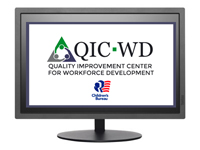Child Welfare Quality Improvement Center for Workforce Development (QIC-WD)
Date of this Version
8-2021
Document Type
Article
Abstract
The Louisiana Department of Children and Family Services (DCFS), Child Welfare Division (CWD), in collaboration with the QIC-WD, implemented a frontline job redesign as its intervention. (For more information see Intervention Background.) An implementation team, including QIC-WD representatives, CWD leadership, child welfare staff from all levels of practice, and human resources and civil service representatives undertook development of the job redesign. Development of the intervention was guided by the following principles:
- children and families are the center and focus of the practice,
- a dual focus on prevention and permanency, requiring increased knowledge and skills in providing both parents and children the supports they need as soon as feasible, and
- teaming as a means of delivering effective and timely services.
Several steps were involved in the development of the redesign model. Initially, the team conducted a job analysis in collaboration with the State Civil Service Commission. This process yielded a comprehensive listing of the job tasks and associated competencies required to perform the work of the child welfare specializations within Louisiana. The team also surveyed Child Welfare Trainees, Child Welfare Specialist (CWS) 1s, 2s and 3s, and Social Service Analysts statewide to find out how they viewed the characteristics and demands of their jobs. They also conducted focus groups representing all areas of practice to verify their job duties. Following this process, supervisory units providing (1) investigation, (2) in-home family services, and (3) foster care were identified as the focus of the redesign intervention. Tasks associated with those three programs were categorized as clinical or administrative, and as essential or as potential candidates for elimination. The tasks nominated for removal were carefully assessed for implications for job functioning, quality of practice, and outcomes for children and families before final decisions were made. The team then considered options for redesign of the CWS job that would accomplish the necessary administrative tasks and enhance clinical work with children and families. They created process maps to model existing and proposed workflows and determined which tasks the child welfare worker would keep, and which tasks could be assumed by a newly created professional position, which was named the Child Welfare Team Specialist (CWTS).
A core element of the intervention was the creation of the CWTS position. The CWTS works in close partnership with the child welfare worker, assuming duties categorized as administrative, thus allowing the child welfare worker to focus on more clinical tasks. The Implementation Team worked with the DCFS Human Resource Director in concert with the Louisiana Civil Service Commission’s Chief Operating Officer to request allocation for this newly created position and the DCFS Undersecretary budgeted for 30 of these new positions in the three parishes designated for implementation in the experiment.
The redesign created two types of restructured work units. First, the formerly separate Child Protective Services (CPS) and Family Services (FS) programs were combined into Prevention teams, with the goal of providing coordinated, clinically based, interventions early in the life of the case to improve outcomes for children and families. Each Prevention team consisted of one supervisor, 3 CPS workers, 2 FS workers, and one CWTS serving as a support to the entire team. A clerical support position provided additional assistance such as document scanning, copying, shredding, and mail.
The second type of team restructuring occurred in the Foster Care (FC) program, resulting in the creation of Permanency teams. The goals of the Permanency teams were to maintain children in safe, developmentally appropriate environments which meet their needs and to assist parents to enhance diminished caretaker protective capacities and eliminate safety threats. In Permanency teams, the foster care workers were paired, and worked closely together on a shared caseload. One worker was focused on working with parents and the other worker was focused on the care and needs of the children. Together, they were able to provide a comprehensive and integrated focus on the needs of the entire family. Each Permanency team consisted of one supervisor, two pairs of permanency workers, a CWTS and a clerical support person. With the provision of these supports and redefined task focus, child welfare specialists were better able to engage in clinical work with families.
Communication within teams was a critical element of the redesign. To address this need, huddles were implemented as a core component of the teaming process. A huddle is a brief team meeting led by a supervisor with their staff designed to identify each person’s assignments and to provide a motivating team building message. They were held at least weekly, sometimes daily, for 15 to 30 minutes. The importance of clear communication also led to the development of orientation meetings and extensive training for all involved personnel to clarify the new model, and the development of job aids, called Role Cards. The Role Cards provided a quick visual reference to the tasks associated with each position’s role in the case process and served as a desk guide for CWTS and child welfare workers as they learned to perform their new or redesigned jobs.
Included in
Industrial and Organizational Psychology Commons, Performance Management Commons, Public Policy Commons, Social Welfare Commons, Social Work Commons, Training and Development Commons


